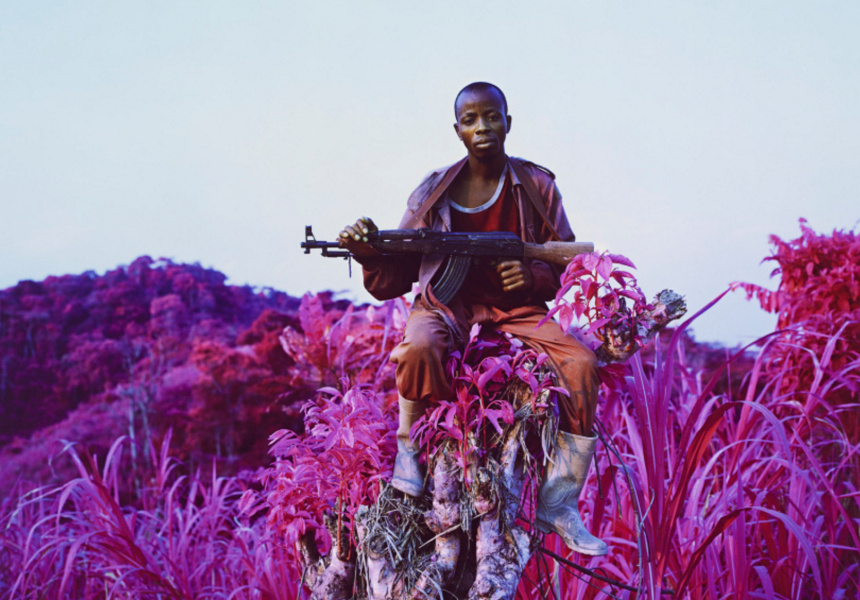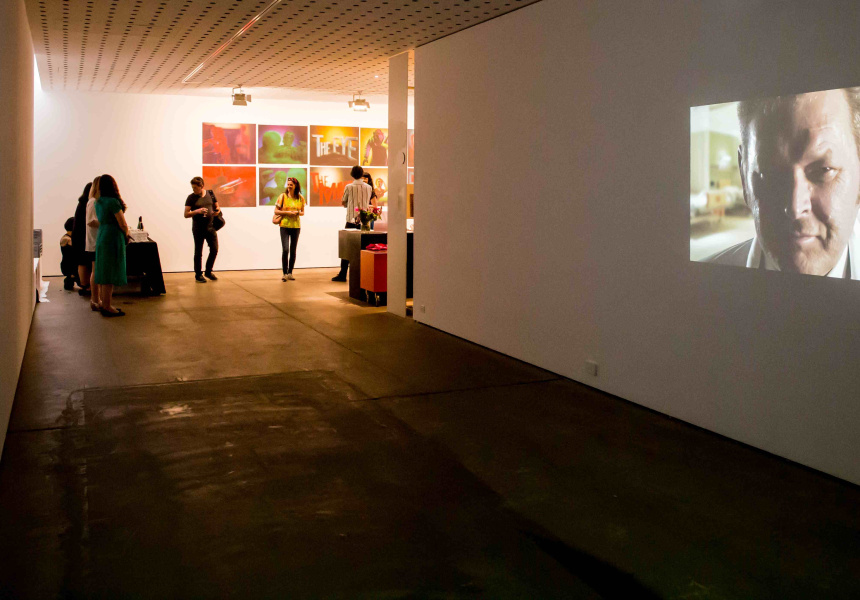From local to international photographers; contemporary to retrospective; moving or still; digital, analogue, or even collages of the two – there are some really exciting exhibitions on in Melbourne right now. Wander into these this weekend.
The Dark Pool by Ronnie van Hout
The lure of ultraviolence.
Barbara Creed’s introductory statement to Ronnie van Hout’s new show at CCP primes the viewer in Freud’s notion of the uncanny – it’s that which is simultaneously familiar and unfamiliar that disturbs us the most. To that end, Ronnie van Hout’s show The Dark Pool takes us to 1971, when two very different pop-cultural events sparked moral panics.
Stay in the know with our free newsletter. The latest restaurants, must-see exhibitions, style trends, travel spots and more – curated by those who know.
SIGN UPThe first: the backlash to Stanley Kubrick’s A Clockwork Orange is well documented. The abject violence and morally ambivalent message saw the film banned in many places. Van Hout restages iconic scenes from the film, casting himself in every role, via two projections on opposing walls. Stand between the moral and the amoral and get stared down by both.
The other was kicked off by an ailing toy company that released a play set encouraging children to stage kidnap and torture scenarios with a variety of monster action figures, and one scantily clad blonde sold as “the victim”. Van Hout’s moody and schlocky close-ups of the figurines make them eerily life-like and disturbing.
The Dark Pool is at CCP until November 15.
The Enclave by Richard Mosse
A warzone in bubblegum pink.
The political situation in Democratic Republic of the Congo is complex; small, vicious wars, decades-long factional hatred and the often-harmful intervention of outsiders all intersect. But Irish photographer and video artist Richard Mosse doesn’t want to lecture you, he wants to get your attention with the human side of the conflict.
His new work at the NGV, The Enclave, is a five-channel video work shot on a rare infra-red film stock. The stock, which was developed by Kodak and the US army during World War Two, highlights natural foliage in bright bubblegum pink. The result is a psychedelic and disarmingly beautiful documentary artwork, raw and confronting, set to a soundscape by Melbourne-born sound artist, Ben Frost. It’s very difficult to tell when the film starts and finishes, where to look when, or get to grips with any context. But that’s the Congo.
Richard Mosse’s The Enclave is at the NGV until February 16.
Photography Meets Feminism by various
Australian women behind the camera in the ’60s and ’70s.
In photography, the rise of second-wave feminism in the ’60s and ’70s had the perfect artistic medium. Photography is cut out for the political: it’s vivid, it’s immediate and it’s real. But the revolution on show here takes place in the consciousness rather than the street.
It’s always fascinating to peer back in time at photographic archives, but the scope of this show is particularly impressive, from Scenes on the Death of Nature, Anne Ferran’s acerbic take on women in classical paintings, to Carol Jerrems’ documentation of now-forgotten sub-cultural movements of urban Melbourne in the ’70s, such as her iconic group portrait, Vale Street. There’s a huge amount to see here. It’s also an opportunity to see the early work of a few people still making great work decades later, such as Julie Rrap and Pat Brassington.
Photography Meets Feminism: Australian Women Photographers 1970s–80s is at the Bundoora Homestead Art Centre until December 6.
Cherry Springs by Sam Shmith
Exploration, stargazing and rollercoasters.
More than half a century ago, fighter pilot Joseph Kittinger took a hot-air balloon 30 kilometres into the sky and jumped out. He set the record for highest balloon ascent, highest parachute jump and fastest speed by a human being through the atmosphere. Two years ago, photographer Sam Shmith spent some time at Cherry Springs State Park in Pennsylvania, USA, a renowned stargazing site. These are the two inciting incidents for Shmith’s new show at Arc One. What might at first look like blurry landscapes and ethereal skyscapes are in fact digital collages: images picked from Shmith’s archive and re-appropriated into new composite images discussing space, travel and descent.
There are echoes of his previous works here, including techniques he used in 2013’s Plate Glass – which drew on images as seen both through and reflected in a glass surface. Next to a motion-blurred shot of the countryside seen from a moving vehicle, there’s a tiny portrait of two people on a rollercoaster; next to a distant angelic figure falling through billowing clouds there’s a night landscape of distant town lights under the stars. Haunting and lingering work.
Cherry Springs is at Arc One until December 5.
Independent Photography Festival by various
Boundary-pushing works from emerging photographers.
After launching in Melbourne four years ago in collaboration with The Good Copy, Smalltime Projects and Hard Workers Club, the celebration of independent photography has gathered momentum and gone global. It’s fresh from New York and LA, and will be touring London and Sydney after wrapping in Melbourne.
Look for Gonzo by Lucien Graetz at Collingwood’s Neospace, a series that merges film photography with subtle, slightly surreal, digital manipulations. He was awarded Judges Choice in 2014’s IPF Photo Prize.
Over at RVCA Corner Gallery, Australian photographer Jesse Lizotte’s second exhibition, Born Too Late, documents a life of subcultures in black and white. It follows from his previous series, Lowrider, which sprang from his immersion in LA’s Chicano lowrider culture. This time, Lizotte focuses on young Japanese men with links to a criminal underworld.
IPF runs from November 7 to 15 at various locations around Melbourne’s inner north.



